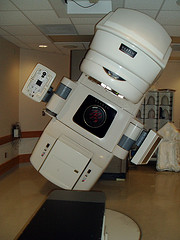Posted on 19 July 2011. Tags: cancer epidemiology, cancers, disparities, liver cancer, lung cancer, medical examinations, mouth cancer, national cancer institute, survival data, types of cancer
 A recent study suggests that men are much more likely to die from majority of specific types of cancer than women in the United States.
A recent study suggests that men are much more likely to die from majority of specific types of cancer than women in the United States.
U.S. researchers from National Cancer Institute cancer epidemiology and genetics division used survival data and vital rates for 36 types of cancer to determine whether survival and mortality rates from cancer differ with gender.
The research found that mortality rates from mouth cancer have the largest gender gap with deaths in 5.51 men for every woman. It is followed by laryngeal cancer at 5.37, hypoparyngeal cancer at 4.47 and esophageal cancer at 4.08.
Also, more men than women die from cancers with high overall mortality rates such as lung cancer with 2.31 deaths in men for every woman, as well as colorectal caner with 1.42 deaths in men for every woman.
Meanwhile, the study showed that there are 1.37 men for every woman who dies from pancreatic cancer, 1.75 for leukemia and 2.23 for liver cancer.
According to the researchers, it was not easy to identify what really caused the gap in gender. But, they cited various tumor behaviors, including disparities in the regularity of medical examinations. For example, men in the United States are more likely than women to be diagnosed with cancer at an advanced stage.
Michael B. Cook, researcher at the National Cancer Institute, said the research suggests that frequency of cancer diagnosis is the main factor that drives the larger rates of cancer mortality in men, instead of poorer survival once the disease occurs.
Posted in Health
Posted on 06 May 2011. Tags: biomarker, cancer cells, high blood pressure, high systolic, journal of the national cancer institute, metastasis, national cancer institute, peer review, rini, tumor growth
 New research shows blood pressure is a great indicator how of end stage kidney cancer patient’s medication is working. Ironically, high blood pressure is linked to better prognosis and longer survival.
New research shows blood pressure is a great indicator how of end stage kidney cancer patient’s medication is working. Ironically, high blood pressure is linked to better prognosis and longer survival.
The proponents of the study observed 544 kidney cancer patients who are being treated with Sutent. The researchers discovered that those people with a systolic BP of more than 40mmHg lived almost four times longer than patients who had lower systolic blood pressure.
Moreover, researchers found out that during the time that the tumor does not shrink or grow is five times longer in patients with high systolic reading – systolic pressure is the top number in blood pressure readings.
Lead researcher Dr. Brian Rini said that the findings of their study supports the theory that hypertension is a biomarker of the drug’s effectiveness in tumor growth. This also means that oncologists should now closely monitor their patient’s BP to gauge Sutent’s job in treating kidney cancer in its advance stage.
Survival rates for kidney cancer are associated with the progression of the cancer, the tumor size, and its metastasis. If the cancer cells have spread in the tissues around the organ, the survival rate will drop to around 60 percent; and it drops further if the cancer cells have attacked the lymph nodes.
This study was successfully published online on April 28 of this year in the Journal of the National Cancer Institute after passing an extensive peer review.
Posted in Health
Posted on 30 March 2011. Tags: cancer patients, cancer type, kinds of cancer, likelihood, lung cancer, national cancer institute, oncology, radiation treatment, researcher, secondary cancer
 A study conducted by the US National Cancer Institute confirms that the likelihood of developing a second cancer after radiation therapy is very low. The long-term study of about 600,000 cancer survivors showed that only 8 per cent of that population developed secondary cancer due to radiation therapy.
A study conducted by the US National Cancer Institute confirms that the likelihood of developing a second cancer after radiation therapy is very low. The long-term study of about 600,000 cancer survivors showed that only 8 per cent of that population developed secondary cancer due to radiation therapy.
The researchers said that among many others, lifestyle and genetic risks are the ones that would likely pre-empt a second cancer.
Amy Berrington de Gonzales, lead researcher, said that the result of the study is a very powerful tool physicians may use to device a treatment plan for their patients. She further said that patients can now be assured that the benefits of undergoing radiation therapy outweigh its risks.
This is the first ever study that was able to quantify the risks that radiation treatment may cause. It was published 30th of March online on The Lancet Oncology.
The research was conducted for 30 years on many different kinds of cancer. Among them are prostate, breast, brain, cervical, and lung cancer. Researchers noticed that development of lung cancer also vary from one cancer type to another. For example, they noticed that it is more predominant among breast and cervical cancer patients.
Elizabeth Ward acknowledges the fact that radiation therapy post risks towards cancer patients. However, she is firm on saying that the benefits outweigh the risks. She also said that thanks to recent technology, we are now more successful on preserving healthy cells during radiation therapy.
Posted in Health
Posted on 14 March 2011. Tags: 10 years, cancer survivors, cdc, centers for disease control, demographics, disease control and prevention, eating healthy foods, forty years, national cancer institute, prostate cancer
 Cancer survivors in United States are growing by number each year, health officials informed on Thursday. At the moment, about one out of 20 adults is afflicted with the disease.
Cancer survivors in United States are growing by number each year, health officials informed on Thursday. At the moment, about one out of 20 adults is afflicted with the disease.
Officials explained why more individuals are surviving cancer, and that is partly because of earlier detection and enhanced treatment.
The Centers for Disease Control and Prevention reported that about 11.7 million residents in United States have history of cancer in 2007. Forty years ago, there were only around 3 million individuals who survived cancer. However, that has grown to 10 million survivors in 2001 and to 11.4 million survivors in 2006.
Health officials said eating healthy foods, decreased smoking and other steps to prevent the disease may have also played a part in the increase.
Also, demographics are a factor that could affect the increase of survivors. Cancer is an illness that is usually common in older people from 65 years old. According to the CDC, 7 million or about 60 percent of the total survivors were aged 65 years and older.
Most of the cancer survivors came from women who were diagnosed with breast cancer. They made up about 22 percent of the survivors. Meanwhile, 19 percent were made up by men who survived prostate cancer.
The estimated number of people who survived cancer came from the National Cancer Institute, as well as CDC. They based their information from nine cancer patient registries located in United States.
Anyone who was diagnosed with cancer, successfully treated, or still getting treated are included in the survivor count. Those people who might be dying from the disease are also included.
Based on the acquired information, there were about 65 percent who had survived cancer for at least five years while about 40 percent had survived it for 10 years or more.
Posted in Health
Posted on 12 November 2010. Tags: adt, cancer cells, heart problems, journal of the national cancer institute, male hormone testosterone, national cancer institute, observational study, older men, prostate cancer, shahinian
 Hormone-blocking therapy used by the male population to treat prostate cancer may increase their risk of developing colon cancer, according to a study published in the Journal of the National Cancer Institute.
Hormone-blocking therapy used by the male population to treat prostate cancer may increase their risk of developing colon cancer, according to a study published in the Journal of the National Cancer Institute.
The drug treatment is called ‘androgen deprivation therapy’ also known as ADT, which is used to suppress the production of male hormone testosterone which increases the development of prostate cancer.
ADT is commonly used to treat prostate cancer even though it has known potential effects such as diabetes and obesity. Diabetes and obesity are the two main risk factors in the development of colon cancer.
The U.S Food and Drug Administration just informed last month that hormonal treatments for prostate cancer such as Lupron and Trelstar should bear new warnings regarding their potential risks of heart problems and diabetes.
According to the researchers, studies in animals suggested that the male hormones stop the signals that cause cancer cells to grow, which in turn suppresses the development of colon cancer.
The authors say it might be possible that inhibiting the release of hormones in the body could lead to greater risk for colon cancer.
Dr. Vahakn Shahinian of the University of Michigan, along with his colleagues studied more than 100,000 older men that were diagnosed with prostate cancer between the years 1993 and 2002.
They discovered that those men who received ADT had about 30 to 40 percent greater risk of developing colon cancer during the follow-up period. However, the case is still based on an observational study, and not a proven cause and effect.
Posted in Health
 A recent study suggests that men are much more likely to die from majority of specific types of cancer than women in the United States.
A recent study suggests that men are much more likely to die from majority of specific types of cancer than women in the United States.
 New research shows blood pressure is a great indicator how of end stage kidney cancer patient’s medication is working. Ironically, high blood pressure is linked to better prognosis and longer survival.
New research shows blood pressure is a great indicator how of end stage kidney cancer patient’s medication is working. Ironically, high blood pressure is linked to better prognosis and longer survival. A study conducted by the US National Cancer Institute confirms that the likelihood of developing a second cancer after radiation therapy is very low. The long-term study of about 600,000 cancer survivors showed that only 8 per cent of that population developed secondary cancer due to radiation therapy.
A study conducted by the US National Cancer Institute confirms that the likelihood of developing a second cancer after radiation therapy is very low. The long-term study of about 600,000 cancer survivors showed that only 8 per cent of that population developed secondary cancer due to radiation therapy. Cancer survivors in United States are growing by number each year, health officials informed on Thursday. At the moment, about one out of 20 adults is afflicted with the disease.
Cancer survivors in United States are growing by number each year, health officials informed on Thursday. At the moment, about one out of 20 adults is afflicted with the disease. Hormone-blocking therapy used by the male population to treat prostate cancer may increase their risk of developing colon cancer, according to a study published in the Journal of the National Cancer Institute.
Hormone-blocking therapy used by the male population to treat prostate cancer may increase their risk of developing colon cancer, according to a study published in the Journal of the National Cancer Institute.